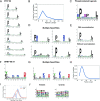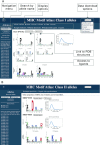The MHC Motif Atlas: a database of MHC binding specificities and ligands
- PMID: 36318236
- PMCID: PMC9825574
- DOI: 10.1093/nar/gkac965
The MHC Motif Atlas: a database of MHC binding specificities and ligands
Abstract
The highly polymorphic Major Histocompatibility Complex (MHC) genes are responsible for the binding and cell surface presentation of pathogen or cancer specific T-cell epitopes. This process is fundamental for eliciting T-cell recognition of infected or malignant cells. Epitopes displayed on MHC molecules further provide therapeutic targets for personalized cancer vaccines or adoptive T-cell therapy. To help visualizing, analyzing and comparing the different binding specificities of MHC molecules, we developed the MHC Motif Atlas (http://mhcmotifatlas.org/). This database contains information about thousands of class I and class II MHC molecules, including binding motifs, peptide length distributions, motifs of phosphorylated ligands, multiple specificities or links to X-ray crystallography structures. The database further enables users to download curated datasets of MHC ligands. By combining intuitive visualization of the main binding properties of MHC molecules together with access to more than a million ligands, the MHC Motif Atlas provides a central resource to analyze and interpret the binding specificities of MHC molecules.
© The Author(s) 2022. Published by Oxford University Press on behalf of Nucleic Acids Research.
Figures




References
-
- Neefjes J., Jongsma M.L.M., Paul P., Bakke O.. Towards a systems understanding of MHC class i and MHC class II antigen presentation. Nat. Rev. Immunol. 2011; 11:823–836. - PubMed
Publication types
MeSH terms
Substances
LinkOut - more resources
Full Text Sources
Research Materials

